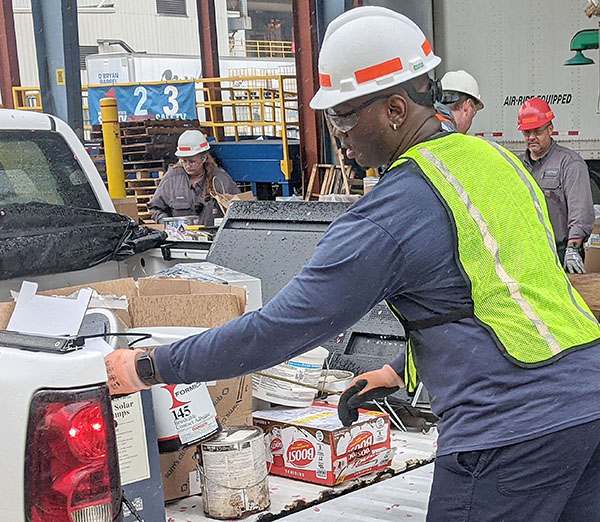
Today we will be continuing with part three of our series of the top questions EPA has received about satellite accumulation areas. Original and complete information from this post can be found in the EPA document on closed containers here.
Question: The preamble to the final rule that added 262.34(c), states, “…only one waste will normally be accumulated at each satellite area.” Can there be more than one hazardous waste at an SAA? Can there be more than one container at an SAA?
Answer: Yes. It’s permissible to have more than one hazardous waste in an SAA. Likewise, it’s permissible to have more than one container of hazardous waste in an SAA. The regulations do not limit the number of hazardous wastes or the number of containers that can be placed in an SAA. The regulations limit only the total volume of hazardous waste at a single SAA to 55 gallons (or 1 quart of acute hazardous waste). If there are multiple containers of hazardous waste in an SAA, each container must be labeled in accordance with 262.34{c)(I)(ii). Because the Agency did not anticipate that generators would accumulate multiple hazardous wastes/containers in an SAA, a cross-reference to the requirements for the safe storage of incompatible wastes was not included as part of the container management standards for SAAs. Nevertheless, good management practices clearly dictate that incompatible wastes should be stored separately. Furthermore, in the event that any wastes, including incompatible wastes, are stored in such a way that they may pose an imminent and substantial threat to health or the environment, §7003 of RCRA allows the Agency to take enforcement action to eliminate the threat.
Question: Can a facility have multiple SAAs?
Answer: Yes. The regulations do not limit the total number of SAAs at a generator’s facility. Likewise, the regulations do not limit the total amount of hazardous waste that can be accumulated at various SAAs across a facility. The regulations limit only the volume of hazardous waste that can be accumulated at a single SAA to 55 gallons (or I quart of acute hazardous waste). It’s not possible in a memo for the Agency to delineate for all situations what constitutes a single SAA versus what constitutes separate SAAs. The regulations state that a generator may accumulate hazardous waste “in containers at or near any point of generation where wastes initially accumulate, which is under the control of the operator of the process generating the waste.” For additional guidance about the Agency’s intent, refer to the preamble to the final rule for SAAs, which states, “Certainly…a row of full 55 gallon drums spaced 5 feet apart along the factory wall,” is not a row of distinct SAAs, but is one SAA.
Question: If a facility has multiple SAAs, can hazardous waste be moved from one SAA to another?
Answer: No. Generators may not move hazardous wastes between SAAs. Once a hazardous waste leaves an SAA, it must be destined for a central accumulation area that is regulated under 262.34(a) or (d) or for final treatment or disposal at a facility with a permit or interim status. However, a single SAA may have multiple points of generation. Movement or consolidation of hazardous waste within an SAA is permissible, as long as it remains “at or near” the “point of generation” and “under the control of the operator of the process generating the waste.”
In addition, a generator may have more than one 90-day or 180-day central accumulation area, and the regulations do not prohibit the movement of hazardous waste from one fully regulated central accumulation area to another, as long as the hazardous waste remains on-site. However, the 90-day or 180-day “clock” for accumulation does not restart if the hazardous waste is moved to another central accumulation area.
Information for this blog post was gathered from the EPA Memorandum on Closed Containers. As always, this blog post is not intended to be comprehensive and it is always best to check with the EPA and local government for full, up-to-date, rules and regulations.
More News From Heritage
-
6/27/24
Heritage Environmental Services to Acquire EBV from General Dynamics
Heritage Environmental Servicess, an EQT Infrastructure portfolio company, will acquire EBV from General Dynamics
-
6/13/24
Meet The Facilities – East Liverpool
An inside look at our incineration facility located in East Liverpool, OH
-
5/24/24
Habitat for Humanity 2024
Heritage hosted our 14th annual Habitat for Humanity build this month, partnering with over 50 employees from various THG companies.
-
5/6/24
Date set for the household hazardous waste collection in East Liverpool, Ohio
-
3/12/24
Equal Pay Day – Spotlighting Our Female Drivers
-
3/8/24
International Women’s Week Spotlight – Shannon Dippel
For International Women's Week, we're spotlighting some of the incredible women in the Heritage family. Our final spotlight is Shannon Dippel.
-
3/8/24
International Women’s Week Spotlight – Susan Adams
For International Women's Week, we're spotlighting some of the incredible women in the Heritage family. Our sixth spotlight is Susan Adams.
-
3/7/24
International Women’s Week Spotlight – Lea Wilson
For International Women's Week, we're spotlighting some of the incredible women in the Heritage family. Our fifth spotlight is Lea Wilson








